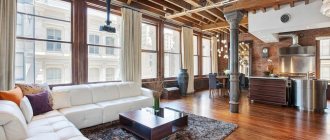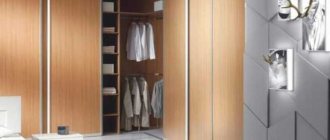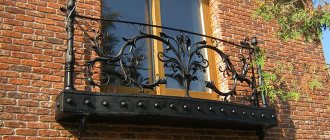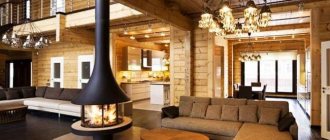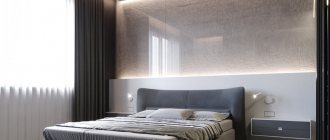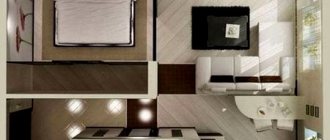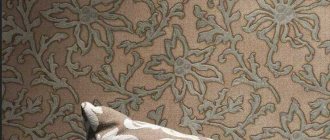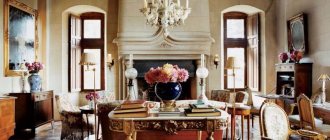History of style
This style originated in the USSR in the mid-30s of the 20th century. Initially, the Empire style was a pompous, majestic architectural style that arose in France during the time of Napoleon the First. In the 30s of the twentieth century, such luxurious, monumental buildings began to be built in the Soviet Union, when J.V. Stalin began to rule the country. In the 50s, such architecture began to be sharply criticized, considering it an excess that was unacceptable for a Soviet person, and after Stalin’s death, all the projects started were sharply simplified, eliminating decor as much as possible, and in some places sharply reducing the total area and ceiling heights. Multi-room apartments were mostly given over to “communal apartments”, in which several families lived at the same time, using a common kitchen and bathroom.
Antique furniture
In the photo: Antique furniture is often used in Stalin-style interiors
Antique furniture looks great in any interior. And furniture from the Stalin era is almost universal. An antique sideboard made of dark wood will well complement the design of a bright kitchen-living room, even made in a modern style. A bookcase from the times of Stalin will add zest to the office. The interior, which contains antique furniture, looks interesting and memorable. Antiques make a space more personal. But be careful when filling your interior with antique furniture. After all, if you overdo it with antique items, you can simply clutter the space. This can happen if you use too many small pieces of furniture. After purchasing a new antique table, replace it with a modern shelf by the bed. Furniture can “move” around the apartment and change its purpose. Don't be afraid to rearrange the furniture, this way you can easily change the interior. Plan the arrangement of large antique items, such as a sideboard, buffet or bookcase, in advance. During the Soviet period, “professorial” apartments were furnished with pre-revolutionary furniture sets, which smoothly transitioned into the style of that time.
Characteristic features of the style
A standard “Stalinka” apartment consists of three to five, less often two or six to seven separate rooms, a kitchen with an area of seven to fifteen square meters, a huge living room, and a spacious hallway. One-room apartments were built extremely rarely, and in three-ruble apartments two rooms were sometimes adjacent. All rooms have ceilings more than three meters high, vertically elongated windows facing one or two sides, and in some places there are bay windows. Typically, such housing is located in the “historical” center of a large city - the view from the windows is appropriate.
Apartment design from the time of Stalin combined individual features of Baroque and Napoleonic Empire, neo-Gothic and Art Deco, classicism and modernity. The thick walls of houses of this era were made of red or white brick and other non-combustible materials, and the buildings themselves had at least two floors, an abundance of stucco, and real columns. The doors here are also quite high, often double-leaf, the walls are decorated with profile cornices, and the wide “front” stairs are decorated with carpet runners.
In another way, “Stalin” buildings were called “full-size apartments” or “full-size in houses of the 50s.” Not only residential buildings, but also theaters, departmental buildings, metro stations, sports facilities, and universities were decorated luxuriously and on a grand scale. City buildings were grouped into entire ensembles; the architects of that time tried to use all the achievements of construction and fine art. The principle “the more the better”, gigantomania and optimism were in effect everywhere.
Which one is better to choose?
The set of interior items remains standard, but new, previously unused designs are used: trellises, narrow display cases, sideboards. The most characteristic furniture for the Empire style is:
- sofas and couches with wide seats, low backs, upholstered in expensive fabrics: leather, brocade or silk. The frame can be made of metal, such as bronze, or natural wood. Wooden parts are usually decorated with figured carvings. An interesting detail can be legs made in the shape of an animal or its paws. Numerous small pillows are a must;
- fairly large chairs with low backs can be decorated with sides depicting antique griffins and swans. Almost always the seats are soft, upholstered in expensive fabrics;
- The chairs look very much like chairs – wide and low. Because of their beautiful upholstery and gilded decorations, they often look like a small royal throne. A small ottoman for feet can complement the set;
- The cabinets are very impressive in size - the minimum width is 130 cm, and are made from solid solid wood. A frequent element of decoration is a mirror, gilded elements, and beautiful curly bronze handles. An innovation can be called a cabinet, a display case behind glass, where valuable objects or beautiful dishes were displayed. The shelves were made of glass;
- tables - round or rectangular, large or small, depending on the functional purpose of the furniture. The legs are usually curly, with beautiful curves. If the table is small, then only one leg is made for it. The manufacturing material can be not only wood, but also marble, and the tabletop is often laid out using the technique of merquetry, mosaic or inlay with stones, sometimes semi-precious. The standard composition is a set consisting of a huge dining table with high chairs;
- the beds, like the rest of the furniture, are large and massive. The headboard attracts attention with beautiful carvings or can be soft, upholstered in expensive material. A canopy can be made from the same material or sofas and ottomans can be installed in the room;
- A crystal chandelier and mirrors cannot be called a piece of furniture, but they occupy a very important place in creating an Empire style interior. This is where the fashion for dressing tables with a mirror came from, and crystal chandeliers have remained in our homes for a long time.
Usually, to complete the interior, furniture in the Empire style is made to order or purchased as a whole set. This is the easiest way to achieve harmony, since all materials have already been matched to each other and correspond to the general color scheme.
The Empire style can be called the culmination of the development of the classical direction. He still adheres to standard forms and strict lines, but already allows for new trends, manifested in lush and elaborate furniture decoration. Nowadays, there are no restrictions, and you can safely implement the most daring ideas involving stylized furniture.
Features of the color palette
The colors of the interiors of the first half of the 20th century are very modest, practically devoid of bright colors. The furniture chosen is predominantly dark, the walls are pastel shades, the carpets are red-brown, the doors between rooms are white, with multi-colored glazing.
The most suitable color combinations:
- linen with mahogany;
- agate gray with terracotta;
- marsh with woody orange;
- antique azure with beige-red;
- lavender with dark brass;
- pale gold with chocolate brown;
- bluish-green with beaver;
- protective blue with light chestnut;
- mustard with iron gray;
- emerald with brick;
- brown-orange with khaki;
- coral with cream;
- creamy yellow with violet-black;
- dandelion with opal green;
- ocher with silver-pink.
Even a monochrome interior allows for bright color accents - curtains, pillows, carpets, paintings on the walls.
Post-perestroika fusion - bright eclecticism
Perestroika, of course, opened the borders, but not too widely. There has been an increase in goods, but not enough to speak of a complete change of eras. Everyone probably remembers that wonderful time with the fashion for bright cherry doors, floors with blue and yellow walls and sofas. In fact, this is the only style that was popular in the 90s. They change it for everything - and not only for bright eclecticism. Such apartments are now being transformed into both modern classics and American art deco. However, most often these types of spaces are transformed into interiors with a “seasonal color combination”. For example, the colors serenity and rose quartz have now gained unprecedented popularity. We get a “whitewashed” blue sofa and pink walls.
What materials to use when decorating rooms
Finishing materials are used exclusively natural:
- stone – mainly granite, marble;
- wood - oak, pine, spruce, cherry, hornbeam, walnut, Karelian birch, etc.;
- metals - bronze, brass, steel, silver, etc.;
- crystal;
- ceramics;
- gypsum.
The floors are usually laid out with parquet, arranged in a herringbone pattern, but not common for the entire apartment, but for each room separately. The walls are decorated with stucco panels, half-columns, plaster brackets, caissons, corner details, textured niches, etc. The ceiling must have a stucco rosette for a chandelier, the same intricate ceiling cornices, and other similar decorations. The doors are made of wood, plywood, have panels, handles painted with gold paint, and platbands with 3D carvings. They match the color of the floor covering or are painted with white oil paint.
The floors in the bathroom and kitchen are laid out with ceramic tiles, less often - with natural stone, mainly red-brown colors, and the walls - with light tiles, richly decorated with plant patterns; a narrow contrasting border is allowed.
Rules for use in the interior
If you find the right approach to the furnishings of the room, then luxurious antique Empire furniture will be perfectly combined with modern design and decoration. This is explained by its massiveness, large number of objects and rich decoration, as well as the necessary symmetry. One of the main needs of such items for a room is space and high ceilings. For small and gloomy rooms, it is worth looking for another solution.
When arranging furniture, it is important to follow the principles of radial or centric composition, which means highlighting the center of the room or interior in some way. To do this, you can use a drawing on the floor in the center, from which you need to start when forming an idea, or, for example, a large dining table.
Finishing and decor must be made in the same or similar colors. It is also advisable to choose a specific material: for example, velvet for upholstering armchairs and sofas, chairs and for sewing curtains in the same room. Fittings are important - it’s great if the handles of doors, chests of drawers, clocks, lamps and other objects are stylized in the same way, for example, bronze.
The color palette should be rich, but not flashy or too bright. White, purple, dark green, and deep blue colors are welcome, which go well with the golden trim of the elements. This is real royal splendor.
It is worth noting that in such a solemn atmosphere you do not always feel completely comfortable, but the Empire style can easily be made “softer”. The market offers a large amount of stylized furniture, including upholstered furniture, which is intended specifically for life, and not for ceremonial and pretentious receptions. This option also contains modest luxury, antique motifs, but not in an elaborate form.
Furniture selection
The furniture chosen is luxurious, high-quality, massive, mainly made of natural wood (oak, walnut, rosewood) and metal. It is often varnished and decorated with 3D carvings and mosaics. These are cabinets with carved “crowns”, convex sideboards, round or oval dining tables, leather chairs and sofas with high backs, heavy wooden chairs with turned legs, beds with balls or peaks in the corners. Wood carving is welcome here both in the form of complex plot bas-reliefs and simple “geometric” designs. Overlay slotted elements made of valuable wood are acceptable. In addition to natural or artificial leather, various fabrics are used as upholstery material - plain or with floral patterns.
Furniture in the Stalinist Empire style: tables, chairs, bookcases
Furniture, as a rule, was made of dark wood - walnut or oak. Furniture made from mahogany looked luxurious. The table in the Stalinist Empire style was often lacquered, usually decorated with crystal vases, which simultaneously served both decorative and practical functions.
The rooms were equipped with tall bookcases, usually with glass doors. A grandfather clock made of dark wood is another detail typical of the Stalinist Empire style. There could be a coffee table in every room, but not from metal or glass, as in our time, but from wood, and its legs were often lavishly decorated with carvings. The walls were predominantly decorated in light pastel colors.
A round table was installed in the dining room, and massive chairs around it.
To give the interior a cozy atmosphere, white tablecloths, massive curtains, figurines, candlesticks, and crystal vases were used. Sideboards were decorated with high-quality dishes, often made of light porcelain. You can give your room an empire style using silverware.
Lighting
The main lighting fixture of this era is a luxurious crystal chandelier located in the middle of the ceiling. Later, similar structures were made of plastic, which significantly affected the appearance and durability of the device. Individual areas were illuminated by floor lamps, often with textile shades decorated with floral patterns and fringe. Wall sconces, usually styled as torches, were mounted on bronze figured brackets above the kitchen table and bed. The workplace was illuminated by a table lamp with a greenish shade on a flexible base. In the children's room, in addition to the main light, there were small night lights, plugged into an outlet, decorated with stone or plastic. In modern times, the design is complemented by LED lighting, which, with the right approach, will not at all disrupt the basic style.
What is characteristic of the Empire style in a modern interior?
The formation of the style was particularly influenced by Napoleon’s numerous military campaigns across Europe and Africa. That is why such an interior contains decorative elements and architectural details from several cultures at once. It is based on the principles of neoclassicism, in particular, massiveness, pomp and monumentality of design. The presence of columns, sphinxes, various ornaments and reliefs is mandatory. The only drawback of the Empire style is that it is only suitable for spacious rooms.
The characteristics of the style are:
- the combination of each design element with pomp, solemnity and monumentality;
- the presence of solemn pomp, and symmetry must be observed;
- presence in the style of Ancient Rome, Greece and Egypt in large quantities;
- use of military paraphernalia;
- rich color scheme, and it is used when decorating walls, floors and ceilings;
- preference is given to massive furniture made of expensive wood, which is particularly refined;
- the presence of large mirrors;
- using a centric or radial composition for arranging furniture and decor.
Empire style is characterized by clear lines and geometric shapes
The Empire style is characterized by solemnity and pomp.
Video: distinctive features of the Empire style
Selecting textiles for window decoration
Window draperies are chosen to be dense, heavy, creating a solemn atmosphere. They have several layers, a large number of folds, fringe, and tassels. In the bedroom, blackout curtains are preferred, protecting the sleeper from the morning sunlight; in the kitchen - shorter, lighter ones. Doorways are decorated with the same curtains as the windows and tied with golden cords. Fabrics are preferable to natural, plain, calm colors or sharply contrasting with the color of the walls. It is advisable that the curtains match the color of bedspreads, carpets, and other indoor textiles.
If there are several windows on one wall, they are decorated with one common curtain, covering almost the entire wall completely.
Style Features
To create furniture in the Empire style, some of the most valuable solids are used, such as mahogany, walnut and others. Such furniture, as a rule, has impressive dimensions and rectilinear shapes, so the rooms are selected accordingly; for example, a dining table could occupy almost the entire dining room.
There are many important elements for creating an interior to suit the style, for example, it is accepted that an empire sofa should have pillows, a lot of mirrors should be used and they can be placed in the most unusual places: above the bed, between windows, above tables. By the way, mirrors above dressing tables appeared thanks to this style.
Despite the craving for luxury, the Empire style can also be quite cozy. Soft, stylish furniture creates a warm, relaxing atmosphere in the room.
The Empire style living room is furnished with appropriate furniture. Correctly selected decorative elements make the overall picture complete and whole.
Cabinet furniture is usually decorated with decorative columns and pilasters. Expensive, natural fabrics such as silk and linen are used for windows and walls.
Elegant stucco is used on the ceilings or they are left in ordinary, classic white; in the simplest version, parquet is laid on the floor, but it is customary to “dress” the floor in marble or other natural stone. Carpets are matched to the color of the furniture. An indispensable detail in the Empire style are sculptural high reliefs depicting a lion, sphinx, swan, and griffin. There should be lamps in every room.
The Empire style dining room set is made of natural wood. The upholstery on the chairs is made of checkered fabric and harmonizes with the overall color scheme of the interior.
The elegant bedroom is decorated in Empire style. A bed with a high headboard upholstered in natural silk stands in the center of the design composition.
Room design examples
The total area of a Stalinist two-room apartment is about 30 meters, a four-room apartment is about 60 meters, a seven-room apartment is up to 160 square meters. The more rooms there were, the more spacious each of them became.
What kind of premises were there:
- kitchen;
- one or more bedrooms;
- cabinet;
- living room;
- bath or shower;
- restroom;
- hall;
- pantry.
There were no dressing rooms in those days - clothes were stored in built-in closets and storage rooms. For children's bedrooms, special furniture, with the exception of a crib, did not exist at all - for these purposes, the smallest rooms were chosen, where they placed a crib, a simple cabinet, a table with a chair, a box with toys, and a bookshelf.
Apartments of the Stalinist era are replete with high built-in wardrobes, which house most of the things, so there is a lot of space in the rooms for books and decorative elements.
Living room
The area of the Stalinist living room is from 16 to 30 square meters. The ceilings and partly the walls are richly decorated with stucco, in the middle there is a multi-tiered crystal chandelier. Along one of the walls there is a wall cabinet, in which there are always many thick books with neat “spines”, and in the glazed sections there are beautiful ceramic dishes, a tea set for six to twelve people, and many porcelain figurines.
The main decoration of the living room is the TV; it is placed on a stand with four cone legs or a wall console decorated with stucco. In the center of one of the walls there is a floor or hanging clock with a chime, richly decorated with carvings; on several others there are paintings in the spirit of rough “Soviet realism”, decorated with heavy frames. Without fail, there is a sofa covered with luxurious drapery, complemented by a pair of armchairs and a carved dressing table. All furniture elements are united by a patterned carpet that occupies most of the room. Photo wallpapers depicting a mid-twentieth century cityscape are also acceptable.
If possible, the principles of symmetry should be observed with respect to the compositional center of the room - fireplace, TV, sofa, painting, etc.
Kitchen
The kitchen of the Stalinist Empire style has an area of 7 to 15 meters. There is usually no kitchen set as such, there is only a not very spacious sideboard with dishes, table linen, and a low round refrigerator. The worktop is made of natural stone or oak; underneath there are drawers, sections for silverware, and various kitchen utensils. A few household appliances are placed on any horizontal surfaces. The dining area is decorated with a dining table covered with a fringed tablecloth; chairs are also draped with removable covers. Crystal fruit bowls, potted foliage plants, and heavy metal candelabra are placed in prominent places.
Bedroom
The average area of any bedroom is about nine meters. A single or double bed is located in the center of one of the walls, the headboard is decorated with stucco moldings, next to it there are one or two bedside tables or a carved dressing table with a valance in the color of the curtains. The shelves above the bed are decorated with black and white photographs in wooden frames and small figurines made of copper or bronze. There is also a small glossy two-door wardrobe, which at that time was locked with a key, or less often - a forged chest for storing linen and various “belongings”. Beige-brown wallpaper with stripes or floral patterns will complement the chosen style. Be sure to lay a carpet on the floor; if desired, it can be supplemented with a wall carpet.
If the room seems cramped, place a large mirror opposite the window, which, by reflecting light from the window, significantly expands the space.
Office-library
It was believed that everyone in the USSR read, so every family had a lot of books. A study with a desk was usually combined with a library, which consisted of solid wood shelves up to the ceiling. Sometimes they hid the surfaces of all the walls, and in order to get the desired book from the top shelf, you had to use a stepladder or a special wooden stand with two or three steps, because the ceiling height was often about four meters.
In the modern version, there may be a little less books, and the desk is replaced by a computer. On open shelves there are plaster or bronze figurines, stylized for that era. A map of the Soviet Union, a red flag or an image of the coat of arms is hung on the wall.
Hallway
This room is decorated no less luxuriously than all the others. There is herringbone parquet or real marble on the floor, dark patterned wallpaper combined with wooden panels on the walls, stucco molding and a ball lamp on the ceiling. From furniture, a carved trellis, a wooden wall or metal floor hanger, a small couch combined with a shelf for installing a home telephone are appropriate here. The carpet will also fit in with the theme.
Apartment design in the Stalin Empire style
At the beginning of the 19th century, almost all apartments were designed in the Stalinist Empire style; everyone without exception wanted to have such an interior in their home. These were really nice apartments with good layouts and spacious rooms. The apartments located in Stalin's high-rise buildings had 4–5 large rooms. Such apartments had high windows designed in the form of a bay window.
The interior in the Stalinist Empire style when decorating the premises was distinguished by the use of such decorative elements as:
- stucco on the ceiling;
- laying parquet in the form of a herringbone;
- availability of sockets for chandeliers.
In apartments decorated according to this direction, a different type of parquet could be used to finish the floors in each room. Carpets were laid on the floors; preference was given to red-colored products, because they emphasized the richness and luxury of the interior.
Interior doors in Stalin's high-rise buildings were white, always with glazing. Often the glazing was made in the form of a mosaic.
The design in the Stalinist Empire style involved the use of expensive crystal chandeliers and sconces.
Elements of Stalinist decor, accessories
The decorative elements of the Stalinist Empire style are very original - five-pointed stars, a hammer and sickle, images of ears of wheat tied with a ribbon, laurel wreaths. These are voluminous plaster or carved panels depicting ordinary working people, enthusiastically working for the benefit of a great country. On shelves, tables, and other prominent places there are bronze, wooden, porcelain figurines or sculptural groups of ideological orientation. There are also bas-reliefs with lions, as well as inlays with paintings of socially significant events.
Soviet interior styles
Soviet interior design changed depending on the situation in the country.
- 20-30s - constructivism.
- 40-50s - Stalinist Empire style.
- 50-80s - Soviet modernism.
Each of the styles still deserves attention today and finds supporters. Many people order apartment interior design with elements of Soviet styles. We invite you to find out more and see photos of the Soviet interior in a new interpretation.
Russian Empire style
Empire style furniture was also made in a completely different direction. The Russian version of the design of interior items was distinguished by the presence of naturalness and rigor. During its manufacture, antique forms and drawings, columns and pilasters were preserved.
However, this was no longer the magnificent French Empire style that originated in Europe. Russian style was distinguished by academicism and restraint. All interior elements fit into the overall picture and were designed in the same style. In addition to mahogany, material painted “to resemble old birch” began to be used. Also, when decorating furniture in the Russian Empire style, embroidery began to be used. Colorful paintings brought homely warmth to the strict profile of interior items.
The Empire style, which was expressed in the objects of the royal palaces, differed from the decor present in the landlord's apartments. The imperial halls and chambers were decorated with armchairs, chairs, and sofas made from the most expensive types of wood. Their decoration was elaborate and beautiful. Furniture for manor estates was made according to palace samples. However, the original sketches were finalized in accordance with the taste preferences of customers. Therefore, greater freedom of creative thought was determined in this direction.
The origin of the style
Today, furniture showrooms in the Rococo, Baroque, and Empire styles are very popular. They seem to have stepped out of the canvases of great artists of the past. The Empire style characterizes the art movements of the 18th century. This style originated in France. Subtle art, charm and at the same time greatness permeate it. Translated from French, empire means “empire”. Therefore, pathos and arrogance, theatricality and sophistication reign in him.
Empire style corresponds to the era of the reign of the great commander Napoleon Bonaparte. The year 1804 is considered to be the heyday of the style. This style existed from 1799 to 1820. The prevailing moods in society and cultural trends at that time left their mark on this style.
The Empire style became the highest point in the development of classicism. This is a rationalistic style, which involves the use of rationality and expediency of furniture. He did not appear spontaneously. It was created by the hand of an artist. That is why all the design elements look so festive and magnificent. They seem to be painted on canvas with a brush.
French Empire
Upholstered furniture in the Empire style, tables, cabinets and cabinets of the French style had an emphasized pathos. Symmetry, clear lines, elaborate, heavy decoration were characteristic of this direction.
The French Empire style uses various motifs for decoration. Most often this is a military theme. For example, peaks, swords, torches, laurel wreaths. Pyramids and trophies could also be depicted. Some pieces of furniture were engraved with the letter N. It symbolized the power of Napoleon, glorifying the great emperor and conqueror.
Chests of drawers were almost completely replaced by low cabinets and counters with two doors. Their top cover had a marble slab that served as a console. The furniture was decorated with high mirrors. The secretaries became completely closed.
Features of modern furniture
By choosing the right furniture for your living room in the Empire style, you can achieve a stunning effect. Antique luxury can be combined with modern design. At the same time, the interior turns out to be original, interesting and exciting.
Chairs in this style have low backs. Their shape is curved and their dimensions are impressive. The upholstery is made of genuine leather or expensive fabric. Couches and sofas are also covered with brocade, velvet or silk. Their backs are also low, but the seat is quite spacious. The frame is made of bronze or wood. The legs are decorated with various ornaments and antique images. Small pillows matching the color of the upholstery complete the composition.
The cabinets are of impressive size. They are created from heavy solid wood. Decorated with mirrors, gilding and elegant handles. The table can have a rectangular or round shape. The legs must have beautiful curves or antique figures. The beds are large in size and have a beautiful headboard. Sometimes canopies are used.
Having considered the features of furniture created in the Empire style, everyone will be able to create a luxurious, unusual interior in an apartment or private house.
Empire style features
Empire style is an artificially created style. It inherited the features of several great civilizations. First of all, it reflected the cultural views of Ancient Greece, Rome, and Egypt.
The name of the style can also be translated from Latin. In this case it will sound like “power”. This is precisely the main meaning of the ancient movement in art and design.
In Russia, at the time of the birth of the Empire style, it was considered good manners to imitate French culture. Therefore, the emerging trends in the design of interiors, furniture and accessories were immediately adopted by the elite of Russian society. Thanks to this, the style was divided into two types. Furniture appeared in the Russian Empire style, as well as the French direction. The first version had more softness and simplicity. France preferred pretentious pathos and luxury.
Furniture Features
Furniture in the Empire style, the features of which determined its belonging specifically to this direction, borrows antique forms. Pilasters, columns, cornices, etc. again appear in the decorative elements. In the decoration of table surfaces there are griffins and sphinxes, caryatids and lion paws.
These are pompous, monumental products. The creative imagination of the authors was somewhat limited by prudence. However, the nobility preferred to strive to replicate the way of life of Ancient Rome. Interiors at this time began to be distinguished by theatricality, flashy decoration with pronounced imitation features.
The Empire style was clearly regulated. Local schools were simply absent at this time. This was expressed in some limitations of creative imagination and precise mathematical calculations. Symmetrical lines, balance and orderliness became the main features of the Empire style.
Folk furniture
Following the traditions of the heyday of the Empire style, craftsmen began to create not only expensive furniture for the nobility, but also relatively cheap products. At the same time, the main features of the style were preserved. The difference was in the materials used.
Representatives of the middle class could afford to buy inexpensive furniture in the Empire style. She was distinguished by her clumsiness, but in general her appearance corresponded to generally accepted canons.
To give the furniture luxury, it was actively decorated with bronze trim. For those who could not afford such decor, the craftsmen offered gilded papier-mâché, which imitated natural metal. This cheap material was also used to make eagle and lion paws. Furniture could also be decorated with swans, griffins, and atlases made of papier-mâché and gilding. There were also Egyptian motifs.
